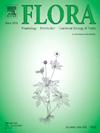The species-specific relationship of leaf mass per area components to light and moisture
IF 1.7
4区 生物学
Q3 ECOLOGY
引用次数: 0
Abstract
The aim of this study was to investigate at the interspecific level to what extent the number of mesophyll cell layers and the leaf dry mass content (LDMC) – key determinants of leaf mass per area (LMA) – adapt to the ambient light and habitat moisture preferred by the species. The number of mesophyll cell layers was indirectly characterised by the quotient of thickness of chlorophyll-bearing mesophyll (Mth) and the anticlinal length of the mesophyll cells (aMCL). The leaves of 131 species from forests and acidic dry grasslands were sampled in the Federal State of Brandenburg in north-eastern Germany. Their light and moisture preferences were characterised using the light and moisture indicator values of Tichý et al. (2023), their geobotanical distribution within terrestrial plant communities arranged along a gradient of community-weighted mean light values and their classification according to preferences for forests and open land (Schmidt et al., 2002). The Mth/aMCL ratios correlated significantly and positively with increasing light levels and negatively with increasing habitat moisture. However, the variability of these relationships was high.
The water relations of the entire plant may differ from those of the leaves, for example due to deep roots. Therefore, LDMC was used to characterise water relations, especially of the leaves. The Mth/aMCL ratio did not correlate with LDMC. The study of light-loving species with known root system data showed that variation in rooting depth and the avoidance of dry periods influenced LDMC but not the Mth/aMCL ratio. This difference in the relationships of the Mth/aMCL ratio to light and moisture, in addition to the high variability in its correlation with light, suggests that the effects of light or moisture on LMA – commonly measured in ecological studies – should be viewed with caution.
求助全文
约1分钟内获得全文
求助全文
来源期刊

Flora
生物-植物科学
CiteScore
3.30
自引率
10.50%
发文量
130
审稿时长
54 days
期刊介绍:
FLORA publishes original contributions and review articles on plant structure (morphology and anatomy), plant distribution (incl. phylogeography) and plant functional ecology (ecophysiology, population ecology and population genetics, organismic interactions, community ecology, ecosystem ecology). Manuscripts (both original and review articles) on a single topic can be compiled in Special Issues, for which suggestions are welcome.
FLORA, the scientific botanical journal with the longest uninterrupted publication sequence (since 1818), considers manuscripts in the above areas which appeal a broad scientific and international readership. Manuscripts focused on floristics and vegetation science will only be considered if they exceed the pure descriptive approach and have relevance for interpreting plant morphology, distribution or ecology. Manuscripts whose content is restricted to purely systematic and nomenclature matters, to geobotanical aspects of only local interest, to pure applications in agri-, horti- or silviculture and pharmacology, and experimental studies dealing exclusively with investigations at the cellular and subcellular level will not be accepted. Manuscripts dealing with comparative and evolutionary aspects of morphology, anatomy and development are welcome.
 求助内容:
求助内容: 应助结果提醒方式:
应助结果提醒方式:


